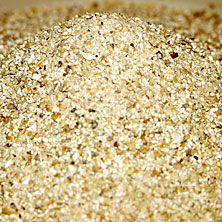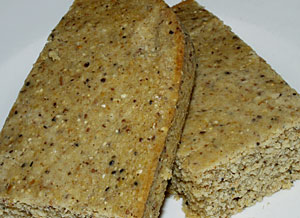The Gift
I first heard about Iroquois White Corn from a farmer friend at a party we went to in Pennsylvania, near the Crayola crayon factory. He told me that it was a delicous heirloom corn that was very unusual. He even gave me three kernels, which I treasured, putting it for safe keeping in a medicine bag on one of our altars at home. For years, I treasured that corn, keeping it safe, wondering if I should plant it out.

Then, at the Bioneers website, I saw the project write up and beautiful pictures, realizing I had forgotten all about it. I immediately called the reservation in upstate New York and spoke with Roberta who gave me lots of information about the corn and how it grows. Apparently, the corn grows to all different heights, ripening unevenly requiring hand harvesting. This explains why this awesome and hardy heirloom corn never made it to industrialization.
She told me because of this, the corn has been grown by families for their own private pantries. It is hand harvested, dried and then smoked and ground to order. John Mohawk and the Slow Food folks have pursuaded many families to begin to produce extra corn guaranteeing them a new market.
I ordered 10 pounds of meal right away, knowing this would be food to be treasured, food that would connect me to generations of Native Americans and our land here, connect me to the traditions of the Americas, nourishing my spirit and my body.
Let's see if we can't guarantee more families a larger market for this wondrous corn and help to keep Iroquois corn the precious heirloom that it is. Order some soon and try my homemade cornbread, for vegetarians, vegans and all food lovers!
Unfortunately, John Mohawk has passed away. You can read a memorial to him at the Bioneers website. We have been unable to find out what has happened to his white corn project. Now, in 2012, i've learned the project has begun again and we can all treasure this original food in all its delicious nourishing splendor! Go the white corn project, visit their website and order up some corn!
Read about this wonderful heirloom corn grown for centuries by the Iroquois people, now re-introduced through the efforts of Slow Food, John Mohawk, a Turtle Clan Seneca (who initiated an Iroquois Food and Farming project back in the 1970’s) and the Pinewoods Community Farming group on the reservation in Western New York. In the 1990’s, the Iroquois growers, academics and others involved in sustainable farming and preservation of heirloom foods grew alarmed as they faced the extinction of this heritage food. Through much effort, a small amount of the corn was available to order.
To order Iroquois White Corn call Ganondagan, in New York State at 585-337-6793.
Recipes
First, the night before, measure a cup of roasted white corn flour into a bowl and add a cup of non GMO organic soymilk. Add 1/4 -1/2 tsp. good sea salt. Mix well, cover and place into the fridge overnight. You can also use water instead of soymilk, in which case leave it out at room temperature overnight. You can also use milk, almond milk, or any other liquid of choice. I like soymilk, cause it gives the bread a good moist 'crumb'.
The next morning, add 1 1/2 tsp. non aluminum baking powder to the mixture and let it sit and 'work' for a few minutes. Then add 1/2 c. spelt flour (you can use white flour, pastry or whole wheat, whatever you like here) to the bowl. Also add a Tbls of good vegetable oil, butter or ghee. Add a Tbls of maple syrup as well or brown rice syrup. Add either one egg, or any substitute you like. (I often bake with ground flax seed beat into water instead of using eggs. See note at end of this recipe.) I often let the mixture sit again for 10-15 minutes before putting into the pan.
Mix well and pour into a square pan approximately 8 inches by 8 inches that's been well buttered.
Bake in a preheated oven for 15-20 minutes, at 425 degrees.
This bread is even better the next day!

Egg Substitution For Vegans or Just Folks Who Like Their Flaxseed!
Grind a couple of tablespoons of fresh flaxseed, then add 1/4 to 1/2 cup of water and beat VERY well. Let sit and you will see the mixture get very mucilagenous. Use this goop instead of eggs. You may have to extend the baking time and even lower the heat at the end and cook more slowly. This adds a great moisture to baked goods and a great flavor.
